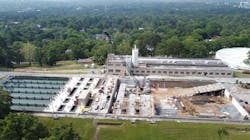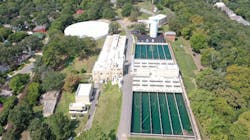In November 2016, the Arkansas Department of Health (ADH) determined the Ozark Point Water Treatment Plant in Little Rock, Arkansas, to be too limited in its treatment to meet state standards.
Even with proper, optimized operation of the facility, meeting strict standards for turbidity, disinfection byproducts and a few other water quality measurements would not be possible long-term.
The plant at that time used rapid mix, flash mix, flocculation, sedimentation, and filtration for its treatment train, and some of that infrastructure had not been changed since plant’s original construction.
The facility was originally built in the 1880s. One of its flocculation/sedimentation basins in use at the time of the comprehensive performance evaluation was part of that original construction, and a second was built in 1927. The Ozark Point WTP is operated by Central Arkansas Water (CAW), and has served the community of Little Rock for more than a century.
Two years after that evaluation from ADH, CAW contracted several companies to update the facility to overcome the treatment limitations identified by the state agency.
“Carollo Engineers, Crist Engineers, and Max Foote Construction Company were able to deliver a modern water treatment facility with significantly improved and reliable processes while preserving the plant’s historical integrity,” said C. Tad Bohannon, CEO of Central Arkansas Water.
Maintaining Local History
The facility is located near a neighborhood with historic homes, and given the 142-year-old age of the water treatment plant, it holds a lot of history for locals. In fact, as part of the upgrades, the building’s construction was designed to reflect the 19th Century architecture.
“The Ozark Treatment Plant is an important part of local history related to the delivery of safe and affordable potable water to the capital city and surrounding communities,” Bohannon said. “Therefore, updating the plant while maintaining its historic character was essential.”
In addition to maintaining that historical character of the building, the facility was also able to be upgraded to ADA compliance, a crucial step in developing the facility’s public outreach program with guided tours.
Flocculation & Sedimentation Basins
At the heart of the Ozark Point treatment train are the two flocculation/sedimentation basins dating back to the 1880s and 1927. The integrity and age of these basins troubled CAW because the concrete mix was unknown. However, petrographic analyses and piezometer readings determined the basins were in good health and reconstruction was not required.
CAW also conducted hydraulic modeling and computational fluid dynamics, which identified the basins were short-circuiting — uneven distribution resulted in recirculation of flow — which aligned with the staff’s experiences. These efforts set the project up for success.
“What made this project so successful is that the groundwork for making effective decisions was set early in the project and continued through design and construction,” said Tom Crowley, project director for Carollo Engineers.
Crews installed modulating flow control valves, baffles, new flocculators, sedimentation basins with new baffles, effluent baffles and sludge collection. Two pumped diffusion flash-mix systems were also incorporated into the design to fit within the available space and offer redundancy to treatment without greatly increasing costs. The rapid-mix chamber was decommissioned to install new flash-mix systems.
Initial operations indicated these changes improved flow spit and chemical dosing, while also enhancing total organic carbon removal.
“We were excited to lead the design team in restoring the WTP. A significant amount of planning is required to identify those elements of the existing facility that can be transformed cost effectively for future use,” said Amber Wooten, project manager for Carollo Engineers.
Filtration Upgrades
The time and energy for operators at the plant were soaked up in the operations and maintenance of the facility’s 12 filters which are each layered in 6 inches and 34 inches of sand. The poor flocculation and sedimentation processes prior to filtration resulted in mudballs, which shortened run times and increased turbidity.
In the ADH report on performance, the agency identified the lack of filter-to-waste processes as an inhibitor to meeting standards in the long term. However, a review of implementing filter-to-waste discovered the footprint, construction of new piping, moving of electrical equipment and improvements to that electric equipment made filter-to-waste impractical. Instead, the team field tested rinse-to-wash processes on three of the filters as it would be easier to implement, and the results showed it to be effective in meeting the needs outlined by ADH.
During construction, the team automated collapsed pulse and extended air and surface washes, RSW, and filter backwash recovery.
About the Author
Bob Crossen
Bob Crossen is the editorial director for the Endeavor Business Media Water Group, which publishes WaterWorld, Wastewater Digest and Stormwater Solutions. Crossen graduated from Illinois State University in Dec. 2011 with a Bachelor of Arts in German and a Bachelor of Arts in Journalism. He worked for Campbell Publications, a weekly newspaper company in rural Illinois outside St. Louis for four years as a reporter and regional editor.


